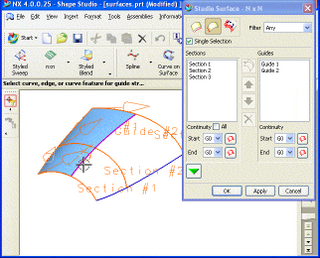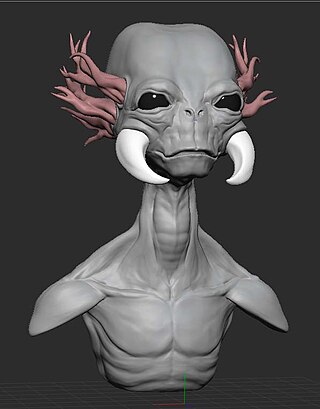
Alias Systems Corporation, headquartered in Toronto, Ontario, Canada, was a software company that produced high-end 3D graphics software. Alias was eventually bought by Autodesk.

A point cloud is a discrete set of data points in space. The points may represent a 3D shape or object. Each point position has its set of Cartesian coordinates. Point clouds are generally produced by 3D scanners or by photogrammetry software, which measure many points on the external surfaces of objects around them. As the output of 3D scanning processes, point clouds are used for many purposes, including to create 3D computer-aided design (CAD) or geographic information systems (GIS) models for manufactured parts, for metrology and quality inspection, and for a multitude of visualizing, animating, rendering, and mass customization applications.

In vector computer graphics, CAD systems, and geographic information systems, geometric primitive is the simplest geometric shape that the system can handle. Sometimes the subroutines that draw the corresponding objects are called "geometric primitives" as well. The most "primitive" primitives are point and straight line segment, which were all that early vector graphics systems had.
Bézier surfaces are a species of mathematical spline used in computer graphics, computer-aided design, and finite element modeling. As with Bézier curves, a Bézier surface is defined by a set of control points. Similar to interpolation in many respects, a key difference is that the surface does not, in general, pass through the central control points; rather, it is "stretched" toward them as though each were an attractive force. They are visually intuitive and, for many applications, mathematically convenient.

Non-uniform rational basis spline (NURBS) is a mathematical model using basis splines (B-splines) that is commonly used in computer graphics for representing curves and surfaces. It offers great flexibility and precision for handling both analytic and modeled shapes. It is a type of curve modeling, as opposed to polygonal modeling or digital sculpting. NURBS curves are commonly used in computer-aided design (CAD), manufacturing (CAM), and engineering (CAE). They are part of numerous industry-wide standards, such as IGES, STEP, ACIS, and PHIGS. Tools for creating and editing NURBS surfaces are found in various 3D graphics, rendering, and animation software packages.
Autodesk 3ds Max, formerly 3D Studio and 3D Studio Max, is a professional 3D computer graphics program for making 3D animations, models, games and images. It is developed and produced by Autodesk Media and Entertainment. It has modeling capabilities and a flexible plugin architecture and must be used on the Microsoft Windows platform. It is frequently used by video game developers, many TV commercial studios, and architectural visualization studios. It is also used for movie effects and movie pre-visualization. 3ds Max features shaders, dynamic simulation, particle systems, radiosity, normal map creation and rendering, global illumination, a customizable user interface, and its own scripting language.

Autodesk Alias is a family of computer-aided industrial design (CAID) software predominantly used in automotive design and industrial design for generating class A surfaces using Bézier surface and non-uniform rational B-spline (NURBS) modeling method.

In 3D computer graphics and solid modeling, a polygon mesh is a collection of vertices, edges and faces that defines the shape of a polyhedral object. The faces usually consist of triangles, quadrilaterals (quads), or other simple convex polygons (n-gons), since this simplifies rendering, but may also be more generally composed of concave polygons, or even polygons with holes.
In the field of 3D computer graphics, a subdivision surface is a curved surface represented by the specification of a coarser polygon mesh and produced by a recursive algorithmic method. The curved surface, the underlying inner mesh, can be calculated from the coarse mesh, known as the control cage or outer mesh, as the functional limit of an iterative process of subdividing each polygonal face into smaller faces that better approximate the final underlying curved surface. Less commonly, a simple algorithm is used to add geometry to a mesh by subdividing the faces into smaller ones without changing the overall shape or volume.

The Catmull–Clark algorithm is a technique used in 3D computer graphics to create curved surfaces by using subdivision surface modeling. It was devised by Edwin Catmull and Jim Clark in 1978 as a generalization of bi-cubic uniform B-spline surfaces to arbitrary topology.

In 3D computer graphics, polygonal modeling is an approach for modeling objects by representing or approximating their surfaces using polygon meshes. Polygonal modeling is well suited to scanline rendering and is therefore the method of choice for real-time computer graphics. Alternate methods of representing 3D objects include NURBS surfaces, subdivision surfaces, and equation-based representations used in ray tracers.

Freeform surface modelling is a technique for engineering freeform surfaces with a CAD or CAID system.

Jos Stam is a researcher in the field of computer graphics, focusing on the simulation of natural physical phenomena for 3D-computer animation. He achieved technical breakthroughs with the simulation of fluids and gases, new rendering algorithms and subdivision surfaces, which are a mix between two previously incompatible worlds of Nurbs- and polygon-modeling in 3D.

In 3D computer graphics, a Doo–Sabin subdivision surface is a type of subdivision surface based on a generalization of bi-quadratic uniform B-splines, whereas Catmull-Clark was based on generalized bi-cubic uniform B-splines. The subdivision refinement algorithm was developed in 1978 by Daniel Doo and Malcolm Sabin.

Digital sculpting, also known as sculpt modeling or 3D sculpting, is the use of software that offers tools to push, pull, smooth, grab, pinch or otherwise manipulate a digital object as if it were made of a real-life substance such as clay.

In computer graphics, the Loop method for subdivision surfaces is an approximating subdivision scheme developed by Charles Loop in 1987 for triangular meshes. Prior methods, namely Catmull-Clark and Doo-Sabin (1978), focused on quad meshes.

In 3D computer graphics, 3D modeling is the process of developing a mathematical coordinate-based representation of a surface of an object in three dimensions via specialized software by manipulating edges, vertices, and polygons in a simulated 3D space.
In computer graphics, free-form deformation (FFD) is a geometric technique used to model simple deformations of rigid objects. It is based on the idea of enclosing an object within a cube or another hull object, and transforming the object within the hull as the hull is deformed. Deformation of the hull is based on the concept of so-called hyper-patches, which are three-dimensional analogs of parametric curves such as Bézier curves, B-splines, or NURBs. The technique was first described by Thomas W. Sederberg and Scott R. Parry in 1986, and is based on an earlier technique by Alan Barr. It was extended by Coquillart to a technique described as extended free-form deformation, which refines the hull object by introducing additional geometry or by using different hull objects such as cylinders and prisms.
Solid Modeling Solutions is a software company that specializes in 3D geometry software.
Thomas W. Sederberg is the associate dean of the college of physical and mathematical sciences and professor of Computer Science at Brigham Young University in Provo, Utah. His research involves computer graphics and computer aided design. He helped invent free-form deformation and T-splines.












